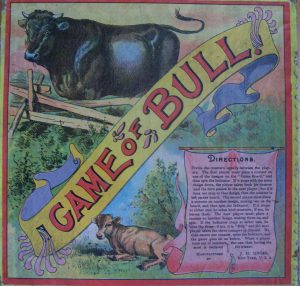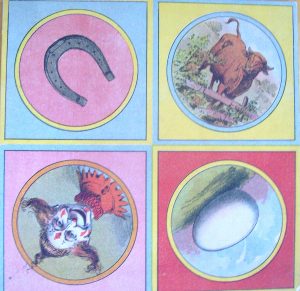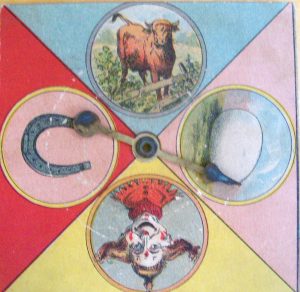 The late 1800’s Game of Bull by J.H. Singer demonstrates a changing time of games. Those of earlier age, like the Mansion of Happiness or the Checkered Game of Life, focused on moral values and provided lessons to life. These types of games gave way to other, more casual, and leisurely fun games.
The late 1800’s Game of Bull by J.H. Singer demonstrates a changing time of games. Those of earlier age, like the Mansion of Happiness or the Checkered Game of Life, focused on moral values and provided lessons to life. These types of games gave way to other, more casual, and leisurely fun games.
Families continued to enjoy games with educational and spiritual aspects, but games played didn’t have to include these qualities. The Game of Bull is an example of this. With its gambling appeal, it is one which could be considered a bit on the edge for the time.
Although the J.H. Singer game company manufactured games for only a short time span, their colorful boxes and boards competed well with the other larger game companies of Mcloughlin Bros., Milton Bradley, or Parker Brothers during the period. The movement from beautifully hand painted games to just as colorful, but cheaper, lithography, afforded the increased production of games, and offered widespread entertainment. Singer took advantage of this while producing wonderful imaged games; such as the Game of Bo Beep, Steeplechase, or Cash. The Game of Bull, today, is also appreciated. It sits well on a shelf with the other collectible games of Mcloughlin Bros. or Milton Bradley.

Playing the Game of Bull could be said to be one of the simplest for games. Place a counter and spin the wheel. It was a game of ‘prediction’ but pure chance. Coming from a period of time when dice were not allowed in games because of ‘gambling’ tendencies (spinners were used instead), the Game of Bull may not have been accepted into all households. This could be one of the reasons why it is a rare find presently.
The board consists of 4 spaces. An image of a clown, horseshoe, egg, and bull are depicted in four corners. A spinner consists of the same. An equal number of counters are distributed to all players. The game begins with one player ‘predicting’ which space his spin will provide. He places his counter on the space of the board and then spins. If he is correct, he takes his counter back. If not, it stays on the board for the next player.

The next player positions another counter on the board and spins. If correct, he takes both counters. If not, it stays for the third to try and collect it. This player sets a counter on the board and spins. Again, if correct, he takes the counters. If not, it is considered Bull and the following player will take all three counters and begins another round.
The winner of the game is the player with the most counters, once one of the players runs out of counters.
As can be imagined, it wouldn’t take much to turn this into a ‘gambling’ game. Instead of counters, place coins. It certainly is tempting to turn any game of pure chance into a more exciting game of gambling. It enlivens things up a bit.
That certainly is why, so many times, the LCR chips are exchanged for money and the winner receives a ‘pot.’
I am thinking people weren’t much different, in this regards, even way back when.
Play a game, any game, today!

